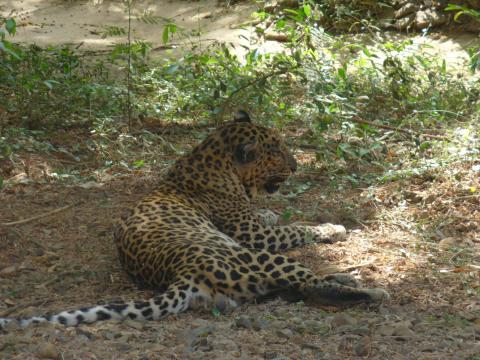Vaccinating dogs protects from wildlife threats
- Community News
- Cases and responses
Several recent stories in the news illustrate how wildlife can significantly impact rabies ecology in a particular region. Wild animals living near humans often interact with local dog populations and can modulate the threat of rabies—sometimes in unexpected ways—but the influence of wildlife on rabies transmission to domestic animals and people can be diminished by a fully vaccinated domestic dog population.
Wildlife can bring rabies into a community and infect non-vaccinated pets, which are then able to transmit the disease to humans. To maintain a barrier between wildlife-transmitted rabies and humans, effective vaccination of domestic and stray dogs in areas bordering wilderness habitats must be established.
Dropping baits to vaccinate wildlife against rabies is another strategy for keeping rabies incidence low in wildlife populations. Israel usually sees about 13-30 rabies cases a year, mostly in wildlife, but news reports have shown that cases have been increasing over the past year, with 17 cases in the first 3 weeks of 2018, and 74 cases in 2017, up from just 29 cases in 2016. The outbreak is attributed to wild jackals crossing over from Jordan—where the government does not treat the disease in domestic or wild animals—that bring the disease into Israel’s northern valleys, heightening the prospect of a severe outbreak. Jackals normally don’t interact with humans, but if infected, they become less inhibited and can more easily transmit the disease to farm animals or pets.
Israel usually controls rabies by scattering edible vaccine in the border regions, but a diplomatic crisis last year between Israel and Jordan prevented last year’s wildlife vaccine distribution program from operating in the region. Over 3000 jackals live in the outbreak area, and reports indicate that the Israeli Nature and Parks Authority is now trying to control rabies in the jackal population by culling and scattering vaccine pellets more densely in problem areas. The Agriculture Ministry wants to ensure that the disease doesn’t cross over to cats and dogs and is inoculating feral cats and providing rabies booster shots free of charge, with the hopes that keeping the domestic animal population protected against rabies will help prevent the outbreak from spreading.
Sometimes critically endangered wildlife fall victim to rabies. Recently, an entire family of wild dogs living in Zimbabwe’s Hwange National Park was eradicated by rabies, infected by with other wild predators in the park. Wild dogs are generally not vaccinated, and without protection from the disease, entire packs have succumbed to rabies, greatly concerning environmentalists and conservationists. A Sierra Club article revealed how vaccinating local domestic dogs around the park has helped prevent the transfer of rabies to and from wild African painted dogs, with the hopes of guarding this endangered species from extinction. The ring of vaccination around the park keeps the disease from spreading to and from domestic dogs and susceptible wild animals.
While unvaccinated wild animal reservoirs can spread rabies, wild predators can also decrease the population density of a reservoir species and reduce disease incidence. A new study published in Frontiers in Ecology and the Environment reported how leopards in Sanjay Ghandi National Park near Mumbai, India hunt stray dogs near the park’s border as their primary source of food. About 40 leopards have been correlated with a lower incidence of rabies compared to surrounding areas of the city. It is estimated that 1500 dogs are killed annually by the leopards, reducing the dog density by a factor of ten compared to the rest of the city—and thereby reducing the incidence of rabies. It was estimated that the culling performed by the park’s leopards prevented 1000 possible bites from dogs and 90 potential rabies cases.
Submitted by Laura Baker, GARC. Summarized from the Sierra Club online magazine, Sierra, “As Rabies Scourges Painted Dogs, a Race to Vaccinate Domestic Breeds”; from the Times of Israel, Animal rabies incidents quadruple, raising fears of outbreak among humans; from the Haaretz, “Israel on the Brink of a Rabies Epidemic, Thousands of Coyotes Killed”; from National Geographic, “How City-Dwelling Leopards Improve Human Health”.
